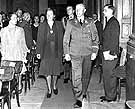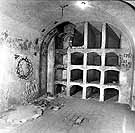
|
|
|

|

|

|

|
|
Click on an image to see a larger, more detailed picture.
|
|
|
|
|
| 1942: The "Final Solution" |

|
pg. 331 |

|
|
|
|
| |
 Gestapo chief Reinhard Heydrich and his wife, Lina, attend a concert in Prague on May 26, 1942, the night before he was ambushed and mortally wounded by Czech partisans. Also the Reichsprotektor of Bohemia and Moravia, Heydrich was charged with rooting out and destroying the increasingly effective underground movement that operated along the Czech countryside. Toward this end, thousands of Czechs were arrested and hundreds killed.
Gestapo chief Reinhard Heydrich and his wife, Lina, attend a concert in Prague on May 26, 1942, the night before he was ambushed and mortally wounded by Czech partisans. Also the Reichsprotektor of Bohemia and Moravia, Heydrich was charged with rooting out and destroying the increasingly effective underground movement that operated along the Czech countryside. Toward this end, thousands of Czechs were arrested and hundreds killed.
Photo: Czechoslovak News Agency / United States Holocaust Memorial Museum Photo Archive
|
 Following the ambush of Reinhard Heydrich, the two assassins and other parachutists who participated in the operation took refuge in the crypt of St. Cyril and St. Methodius, located in Prague. Once their hiding place was discovered, German troops stormed the crypt. A gun battle ensued, and all of the partisans were killed.
Following the ambush of Reinhard Heydrich, the two assassins and other parachutists who participated in the operation took refuge in the crypt of St. Cyril and St. Methodius, located in Prague. Once their hiding place was discovered, German troops stormed the crypt. A gun battle ensued, and all of the partisans were killed.
Photo: Czechoslovak News Agency / United States Holocaust Memorial Museum Photo Archive
|
|
Spain and the Holocaust Although Spain's head of state, General Francisco Franco, sympathized with the Axis powers, his political policies saved an estimated 17,000 Jews from death camps. Franco refused to enter the war. Instead, he declared Spain a "nonbelligerent," and during the latter half of the war changed the country's status to "neutral." Franco frustrated the SS by declaring descendants of Sephardic Jews eligible for Spanish citizenship, and thus entitled to asylum in Spanish embassies. Spain consequently became a main avenue of escape for Europe's Jews. Some hoped to find asylum within the country, but most intended to embark from Spanish ports for sanctuary overseas. The fall of France in 1940 unleashed a flood of refugees seeking entry into Spain. Initially, the Spanish government willingly granted transit visas, but then authorities became more hesitant to open frontiers. Still, many refugees slipped across the northern border illegally, trekking over hazardous mountain routes. By the summer of 1942, Jewish aid organizations helped an estimated 7500 pass through Spain to continue their journeys. Spanish authorities worked to discourage refugees from remaining in the country, and established internment camps for those who did. When border crossings increased again in 1943, refugees were permitted to live in Spanish cities.
|
|

|

|

|

|
 June 15, 1942: Authorities in Riga, Latvia, request a second gassing van.
June 15, 1942: Authorities in Riga, Latvia, request a second gassing van.
|
 June 16, 1942: The American chargé d'affaires in the Vatican, Harold Tittmann, reports to the State Department that Pope Pius XII is adopting "an ostrich-like policy towards atrocities that were obvious to everyone."
June 16, 1942: The American chargé d'affaires in the Vatican, Harold Tittmann, reports to the State Department that Pope Pius XII is adopting "an ostrich-like policy towards atrocities that were obvious to everyone."
|
 June 18, 1942: Jozef Gabcik and Jan Kubis, British-trained Czech partisans who mortally wounded Reinhard Heydrich on May 27, are discovered with several other partisans inside Prague's Sts. Cyril and Methodius Church. The church is besieged by German troops and SS. All partisans perish.
June 18, 1942: Jozef Gabcik and Jan Kubis, British-trained Czech partisans who mortally wounded Reinhard Heydrich on May 27, are discovered with several other partisans inside Prague's Sts. Cyril and Methodius Church. The church is besieged by German troops and SS. All partisans perish.
|
 June 19, 1942: Jews revolt at Glebokie, Belorussia; 2500 are murdered in the Borek Forest.
June 19, 1942: Jews revolt at Glebokie, Belorussia; 2500 are murdered in the Borek Forest.
|
 Summer 1942: The Third Reich achieves its high point of conquest and territory.
Summer 1942: The Third Reich achieves its high point of conquest and territory.
|
 Summer 1942: Three-year-old Jewish twins in Sosnowiec, Poland, Ida and Adam Paluch, are spirited away from Gestapo agents by their aunt and sent to live with separate Catholic families; See 1995.
Summer 1942: Three-year-old Jewish twins in Sosnowiec, Poland, Ida and Adam Paluch, are spirited away from Gestapo agents by their aunt and sent to live with separate Catholic families; See 1995.
|
|
|
|
|
| 1942: The "Final Solution" |

|
pg. 331 |

|
|
The Holocaust Chronicle
© 2009 Publications International, Ltd.
|
|
